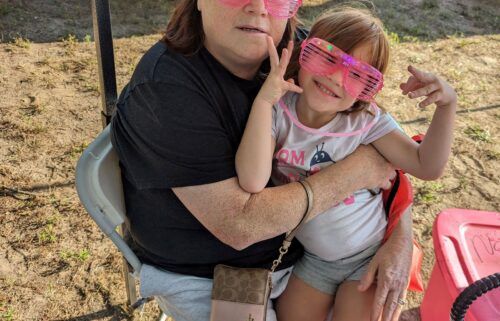How to quarantine your child exposed to Covid-19 at school

Ping! It’s the email you’ve been dreading — your child may have been exposed to Covid-19 at school. How are you to cope with the next two weeks of quarantine and the fear that your child — or another member of the family — may fall ill?
By being prepared, experts say. Here’s what you need to know and do.
Get ready now
Plan well in advance by setting up a structure in which all family members and potential caregivers know their roles and expectations.
Is someone already fully vaccinated? That person should be the first choice as primary caregiver. Assign a backup in case they are sidelined by work or other commitments.
Provide a list of emergency phone numbers, including all family members, your health care provider, the local public health department, local hospital and ambulance service — just in case.
Develop a network among people outside the home, such as extended family, friends and neighbors, who could drop off groceries, medications or other last-minute necessities. This is especially important for single parents, CNN Medical Analyst Dr. Leana Wen said.
“Figure out if you have a friend, neighbor, colleague or relative nearby who can be your backup person,” said Wen, who is an emergency physician and visiting professor of health policy and management at the George Washington University Milken Institute School of Public Health.
“If you end up quarantined with your child as you’re caring for your child, that other person can help you with groceries and medications if needed. If you have friends who are single parents, consider offering to be their backup help. We are all in this together and need to help one another get through this time,” Wen said.
Alternatively, investigate whether your local grocery store makes home deliveries or research online grocery delivery services and set up an account as a precaution.
Have a designated bedroom ready to use, preferably with a private bathroom that no one else will use. Stock the bedroom with all relevant forms of entertainment: TV, computer, iPad, books, even games that you could play via FaceTime or Skype.
Here’s a list of basic supplies to have on hand:
- A working thermometer to monitor fever, which is considered to be 100 degrees Fahrenheit (37.7 degrees Celsius).
- Fever-reducing medications, such as acetaminophen.
- A box of rubber or latex disposable gloves and face masks.
- Regular soap and at least 60% ethanol- or 70% isopropanol-based hand sanitizer (antibacterial soap isn’t necessary if you wash properly, and that way you won’t contribute to the world’s growing antibiotic-resistant superbugs).
- Tissues to cover sneezes and coughs. But there is really no need to hoard toilet paper — this is a respiratory disease.
- Regular cleaning supplies, kitchen cleaning gloves and trash can liners.
- Disinfectant cleaning supplies — you can choose from a list that meets the virus-fighting standards of the US Environmental Protection Agency, or you can also make your own version by using 1/3 cup unexpired bleach per gallon of water or 4 teaspoons bleach per quart of water. Never mix bleach with ammonia or any other household cleaner — it produces toxic gases.
Picking up your child
The US Centers for Disease Control and Prevention recommends picking up your child from school alone, with windows open for ventilation. If you do have other children with you, everyone should be masked unless the child is under the age of 2.
“If possible, wait 24 hours before cleaning and disinfecting your car, as that allows more time for the amount of virus in the air of your car to die off,” the CDC said.
Once your child is home
First, call your child’s health care provider to discuss whether your child needs to be evaluated and to determine options for getting tested for Covid-19, the CDC advises.
Then comes the hard part — isolating your child at home in that separate bedroom and bathroom for 10 to 14 days, the amount of time the CDC recommends.
Ideally, there would only be one primary caregiver, someone who has already been fully vaccinated, who would care for the child “in one part of the house, not sharing rooms with others,” Wen said.
“Keep everyone else separate from the child and the adult caregiver,” Wen said.
“If there are people in the household who are unvaccinated and at high risk for severe outcomes from coronavirus — for example an immunocompromised child or older adult with severe underlying conditions — try to keep that person on the other side of the house or in some area where there is no shared public space.”
The age of the child is a factor here as well, Wen said. An older child may be able to care for themselves, thus allowing caregivers to set food and drink outside the door.
“If it’s a baby, toddler, or younger child who needs a caregiver’s physical support, this will be harder,” Wen said.
“Again, I’d designate one caregiver who is essentially quarantined with the child. That caregiver can still try their best to reduce infection risk to them by wearing a mask and washing hands very well, but it may be very difficult to avoid physical distancing in caring for a young child.”
Do other vaccinated parents in the home have to quarantine? That’s complicated, Wen said.
“The CDC says that fully vaccinated people who are in contact with someone known to have coronavirus do not need to quarantine. However, in this situation, I would err on the side of caution,” Wen said.
The designated caregiver is at high risk for contracting coronavirus, she added, explaining “that risk is much reduced if they are vaccinated, but that person shouldn’t also be interacting with others as they could still be a carrier.”
Members of the family who are fully vaccinated and do not have any contact with the child probably can go about their daily activities, Wen said,”But again, I’d be extra cautious during this period. Other children should quarantine and not be going to school, if one child is known to be infected.”
Cover up and disinfect
Any caregivers should wear a face mask at all times when interacting with your child — even if you and other adults in the family are fully vaccinated, Wen said. “The vaccines are very effective at preventing Covid-19 but not 100%.”
Real world studies of the Pfizer-BioNTech and Moderna vaccines show they are only 90% protective against the coronavirus, not 95% as reported in clinical trials. In real numbers, that’s 10 people out of every 100 who may still catch the novel coronavirus even when fully vaccinated.
Plus, “we’re still learning how effective the vaccines are against variants of the virus,” the CDC said recently, as well as “how long COVID-19 vaccines can protect people.”
Another good idea to reduce risk is to open as many windows and doors as possible to keep fresh air circulating, thus diluting any virus in the air.
“Being in a shared space with a child who is actively infectious, for long periods of time, exposes you to risk,” Wen said. “It may not be possible to limit time together or to physically distance, especially with a young child, so try to improve ventilation by opening windows and keep a mask on yourself.”
Although “direct contact and sharing air” are the main ways experts now believe Covid-19 is spread, Wen said, you can reduce risk for yourself and others in the household by following these tips from the CDC:
- Don’t share drinking glasses, cups, forks or other eating utensils.
- Don’t share towels or bedding.
- Don’t shake the isolated child’s dirty clothes to “minimize the possibility of dispersing virus through the air.”
- Wear disposable gloves when cleaning the child’s bedroom or bath, but then toss them before moving on to other cleaning chores. “Clean hands immediately after gloves are removed,” the CDC said.
- Dedicate a lined trash can for any tissues or other paper or disposable products used by an isolated or sick person, the CDC says, adding that caregivers should “use gloves when removing garbage bags, handling and disposing of trash. Wash hands after handling or disposing of trash.”
- Have everyone in the house wash their hands at every opportunity. Clean and disinfect all those commonly shared surfaces — don’t forget the refrigerator and microwave handles.
Watch for symptoms
Children may not have any noticeable symptoms at all. “As many as half of pediatric infections may be asymptomatic,” the CDC says.
When children do show symptoms, they are typically mild, but that doesn’t mean that a child cannot get seriously sick, the CDC adds.
Just like adults, children with preexisting conditions such as “obesity, diabetes, asthma or chronic lung disease, sickle cell disease, or immunosuppression might also be at increased risk for severe illness from COVID-19,” the agency warns.
Possible symptoms of Covid-19 infection are similar to many other viral infections and include fever, fatigue, headache, muscle or stomach pain, poor appetite, sore throat, cough, nasal congestion, shortness of breath, nausea, vomiting and diarrhea.
Some symptoms that appear to be rather unique to Covid-19 are a new loss of taste or smell and “Covid toes,” swollen red or purple toes caused by tiny blood clots in the smallest blood vessels.
“Although children manifest many of the same symptoms of Covid-19 infection as adults, some differences are noteworthy,” the American Academy of Pediatrics says.
“According to the CDC, children may be less likely to have fever, may be less likely to present with fever as an initial symptom, and may have only gastrointestinal tract symptoms.”
Although rare, kids under than 21 can be at risk for MIS-C, short for multisystem inflammatory syndrome in children. It’s characterized by “persistent fever, abdominal pain, vomiting, diarrhea, skin rash, mucocutaneous lesions and, in severe cases, with hypotension and shock,” according to the CDC.
Parent should keep watch for these symptoms and reach out immediately to a health care provider, emergency room or 911. One last, very important thing: Call 911 immediately if your child or other family member develops any of these symptoms:
- Increased or sudden difficulty breathing or shortness of breath.
- A persistent pain or pressure in the chest.
- Any sign of oxygen deprivation, such as new confusion, bluish lips or face, or you can’t arouse the sick person.
When can your child go back to school?
That could depend on the extent of your child’s risk when exposed, subsequent symptoms, school policies and more, so keep in close contact with your child’s school and your pediatrician.
Minimum requirements by the CDC for a child with symptoms include the following:
- It has been at least 10 days since symptoms started.
- Overall symptoms have improved.
- The child has no fever for at least 24 hours (without fever-reducing medication).


